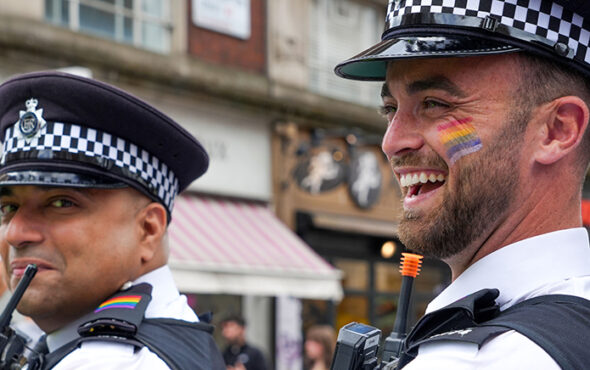
The Met Police has announced the return of full time LGBTQ+ liaison officers in London as part of its “commitment to rebuilding the trust” with the community.
Content warning: This story includes topics that could make some readers feel uncomfortable and/or upset.
The roles were created in conjunction with LGBTQ+ people and the LGBT+ Independent Advisory Group (IAG), feedback from which showed it that “the expectations and requirements of LGBT+ community liaison had changed.”
LGBT+ Community Liaison Officers (CLOs) will provide support and advice to peers, colleagues and members of the public on LGBTQ+ issues.
“It’s our duty to protect and serve all members of our community, regardless of their sexual orientation, gender identity or other characteristics,” said PC Sam Varnham, the CLO for Harrow, Barnet and Brent. “It’s important that we work to create a world where everyone can feel safe and accepted for who they are.
“As a CLO I will get to know my local community and help to build bridges so we can support LGBT+ people better and work together.”
READ MORE: West Midlands Police refuses to apologise for history of LGBTQ+ “witch hunts”
The announcement comes just a week after Commissioner Sir Mark Rowley responded to a campaign from the Peter Tatchell Foundation and officially accepted that the Met “had systems and processes in place which have led to bias and discrimination in the way we have policed London’s communities, and in the way we have treated our officers and staff, over many decades.”
Leading human rights campaigner Peter Tatchell praised Rowley for “backing up his apology to the LGBT+ community with concrete action.”
“Restoring these dedicated LGBT+ liaison officers will strengthen collaboration between the police and local LGBT+ communities across London,” he added. “It will help the fight against homophobic hate crimes and ensure better protection for LGBT+ Londoners.”
“There is deep seated homophobia within the Met”
The officers are being brought in to address the Casey Report, which was released in March 2023 and concluded that the Met is in need of a “complete overhaul” due to being institutionally homophobic, racist and sexist.
Louise Casey spent a year investigating the Met after a review was commissioned in the wake of one of its officers, Wayne Couzens, abducting, raping and murdering Sarah Everard in March 2021.
She said the force is likely to have more officers like Couzens, as well as serial rapist David Carrick, who also worked for the Met.
READ MORE: Met Police is institutionally homophobic, racist and sexist, review finds
The 363-page report also found evidence of “deep seated homophobia” in the force, as well as evidence of widespread bullying and racism.
“There is deep seated homophobia within the Met, as shown by the fact that almost one in five lesbian, gay and bisexual Met employees have personally experienced homophobia and 30% of LGBTQ+ employees have said they had been bullied,” part of it said. “Trust, confidence and fairness scores among LGBTQ+ Londoners have fallen significantly.”
Met’s failures to capture serial killer Stephen Port “could happen again”
Just a month later, findings from an inspection by His Majesty’s Inspectorate of Constabulary and Fire & Rescue Services (HMICFRS) showed that the Met’s failures to capture serial killer Stephen Port “could happen again” as the force has not learned enough from the case.
From June 2014 to September 2015, Port murdered at least four men – Anthony Walgate, 23, Gabriel Kovari, 22, Daniel Whitworth, 21, and Jack Taylor, 25 – before being arrested on 15 October 2015.
READ MORE: Stephen Port: Failures in Met Police’s murder investigation “could happen again”, inspection finds
Port met his victims online (including gay dating app Grindr) before leading them to his home in Barking, London where they were given lethal doses of a date rape drug before being raped and killed.
The MPS failed to link the fatalities despite the striking similarities between them, such as the bodies of three of the four known victims being discovered at the same graveyard in Barking.



